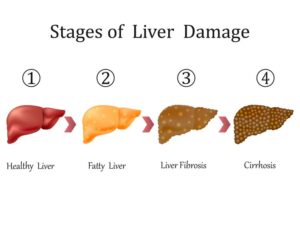
Introduction
Fatty liver disease is one of the most common yet often overlooked health conditions worldwide. While having some fat in the liver is normal, when fat exceeds 5-10% of the liver’s weight, it becomes a cause for concern. Known as a “silent threat,” fatty liver disease may not show symptoms initially but can lead to severe complications if untreated. This article explains the causes, symptoms, types, and treatment options for fatty liver disease, with insights from a trusted gastroenterologist in Surat.
What Is Fatty Liver Disease?
Fatty liver disease occurs when excessive fat builds up in the liver cells. It affects people of all ages but is more common in individuals with specific risk factors such as obesity, poor dietary habits, high cholesterol, or excessive alcohol consumption.
There are two main types:
- Non-Alcoholic Fatty Liver Disease (NAFLD): Not linked to alcohol, it often results from metabolic conditions like obesity and diabetes.
- Alcoholic Fatty Liver Disease (AFLD): Caused by excessive alcohol consumption, this type can progress to liver damage if drinking continues.
Why Is Fatty Liver Disease Called a “Silent Threat”?
Fatty liver disease is often asymptomatic in its early stages. Many people discover it only after routine blood tests or imaging studies for unrelated issues. Without visible symptoms, the disease quietly progresses, potentially leading to severe conditions such as liver inflammation, fibrosis, cirrhosis, or even liver failure.
Causes and Risk Factors
Several factors contribute to the development of fatty liver disease:
- Unhealthy Diet: Diets high in sugar, refined carbs, and unhealthy fats can increase fat accumulation in the liver.
- Obesity: Excess body weight is a major risk factor, especially if the fat is concentrated around the abdomen.
- Diabetes and Insulin Resistance: These conditions increase fat deposition in the liver.
- High Cholesterol or Triglycerides: Elevated levels of fats in the blood can lead to fat buildup in the liver.
- Alcohol Consumption: Even moderate alcohol intake over time can result in alcoholic fatty liver disease.
- Genetic Predisposition: A family history of liver disease can increase susceptibility.
Recognizing the Symptoms
While the early stages of fatty liver disease are usually symptomless, as the condition worsens, individuals may experience:
- Fatigue and weakness
- Discomfort or pain in the upper right abdomen
- Unexplained weight loss
- Jaundice (yellowing of the skin and eyes)
- Swelling in the abdomen or legs
If you notice these symptoms, consult a healthcare professional promptly.
Diagnosing Fatty Liver Disease
Diagnosing fatty liver disease involves a combination of tests and evaluations:
- Medical History and Physical Exam: Doctors assess lifestyle, dietary habits, and alcohol consumption.
- Blood Tests: Elevated liver enzymes may indicate liver damage.
- Imaging Studies: Ultrasound, CT scans, or MRIs help detect fat accumulation in the liver.
- Liver Biopsy: In some cases, a small sample of liver tissue is examined to assess the extent of damage.
Early diagnosis can prevent further progression and allow for effective intervention.
Stages of Fatty Liver Disease
Fatty liver disease develops in stages, each more severe than the last:
- Simple Fatty Liver (Steatosis): Excess fat builds up but doesn’t cause inflammation.
- Non-Alcoholic Steatohepatitis (NASH): Inflammation and liver cell damage occur, increasing the risk of scarring.
- Fibrosis: Persistent inflammation leads to scarring in the liver.
- Cirrhosis: Extensive scarring impairs liver function, potentially leading to liver failure or cancer.
Treatment and Lifestyle Changes
The good news is that fatty liver disease is reversible in its early stages. Treatment focuses on addressing the root causes and adopting healthier habits.
1. Diet and Nutrition
- Eat a balanced diet rich in fruits, vegetables, whole grains, and lean protein.
- Avoid sugary drinks, processed foods, and saturated fats.
- Incorporate healthy fats like those found in nuts, seeds, and fish.
2. Physical Activity
- Aim for at least 30 minutes of moderate exercise, such as walking, cycling, or swimming, five days a week.
- Regular physical activity helps reduce fat deposits in the liver.
3. Weight Loss
- Losing just 5-10% of your body weight can significantly reduce liver fat.
- Combine a healthy diet with regular exercise to achieve sustainable weight loss.
4. Limit Alcohol Intake
- Reduce or eliminate alcohol consumption, especially if diagnosed with alcoholic fatty liver disease.
5. Medications and Medical Supervision
- Depending on the severity, doctors may recommend medications to manage cholesterol, diabetes, or other underlying conditions.
Preventing Fatty Liver Disease
Prevention is key when it comes to liver health. Here’s how you can keep your liver in optimal condition:
- Maintain a healthy weight through a balanced diet and regular exercise.
- Monitor and manage cholesterol, blood pressure, and blood sugar levels.
- Avoid excessive alcohol consumption.
- Stay hydrated and include liver-friendly foods like leafy greens, berries, and garlic in your diet.
When to Seek Medical Help
If you have risk factors for fatty liver disease or experience symptoms, don’t delay seeking medical advice. Early intervention can make a significant difference in preventing complications. Reach out to a trusted specialist to evaluate your liver health and receive tailored recommendations for management.
Conclusion
Fatty liver disease may be a silent threat, but with awareness and proactive measures, it’s a manageable condition. Whether you’re seeking diagnosis, treatment, or preventive guidance, the right medical support can make all the difference. Take the first step toward better health today—because a healthy liver is vital for a healthy life.
